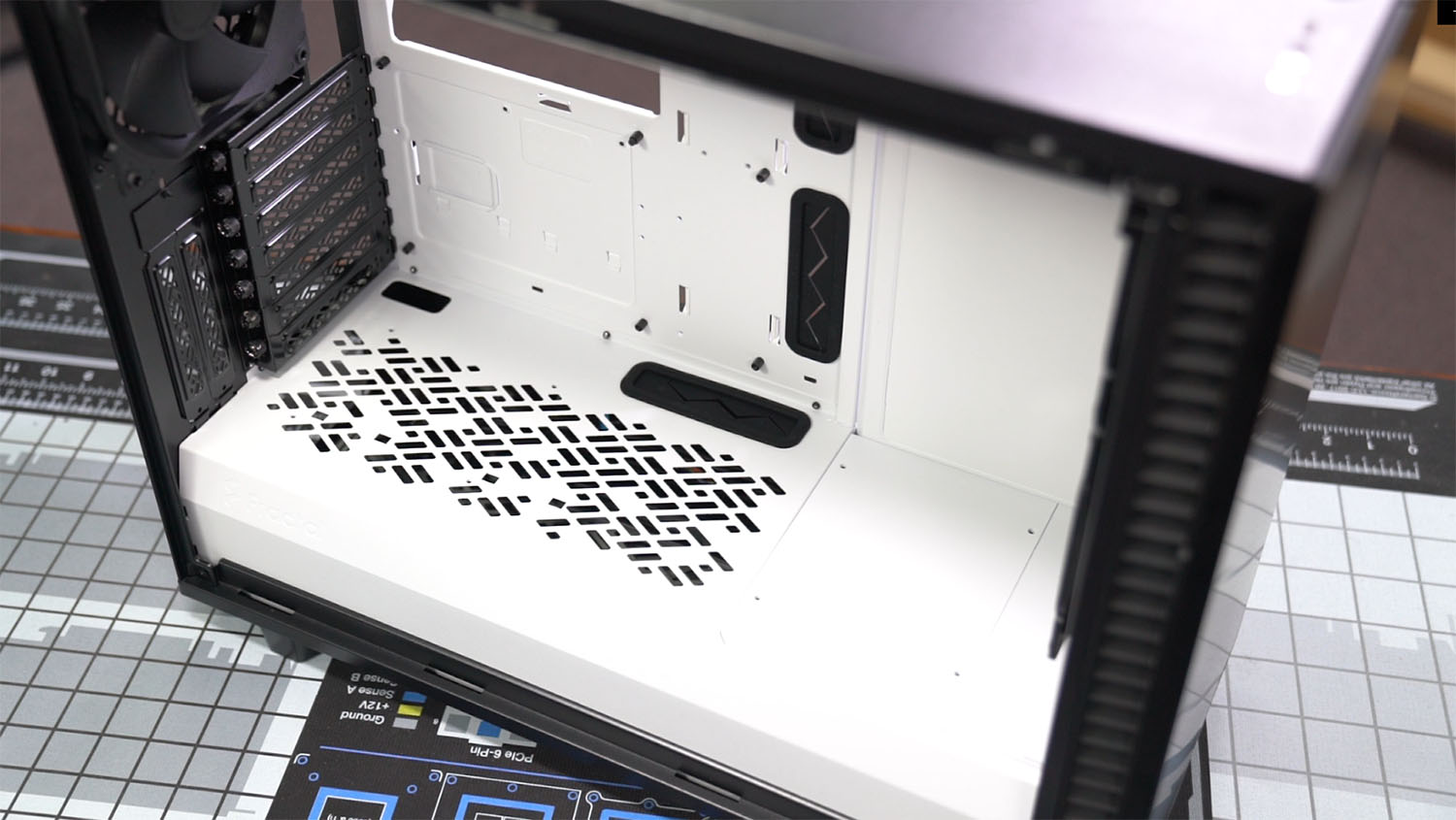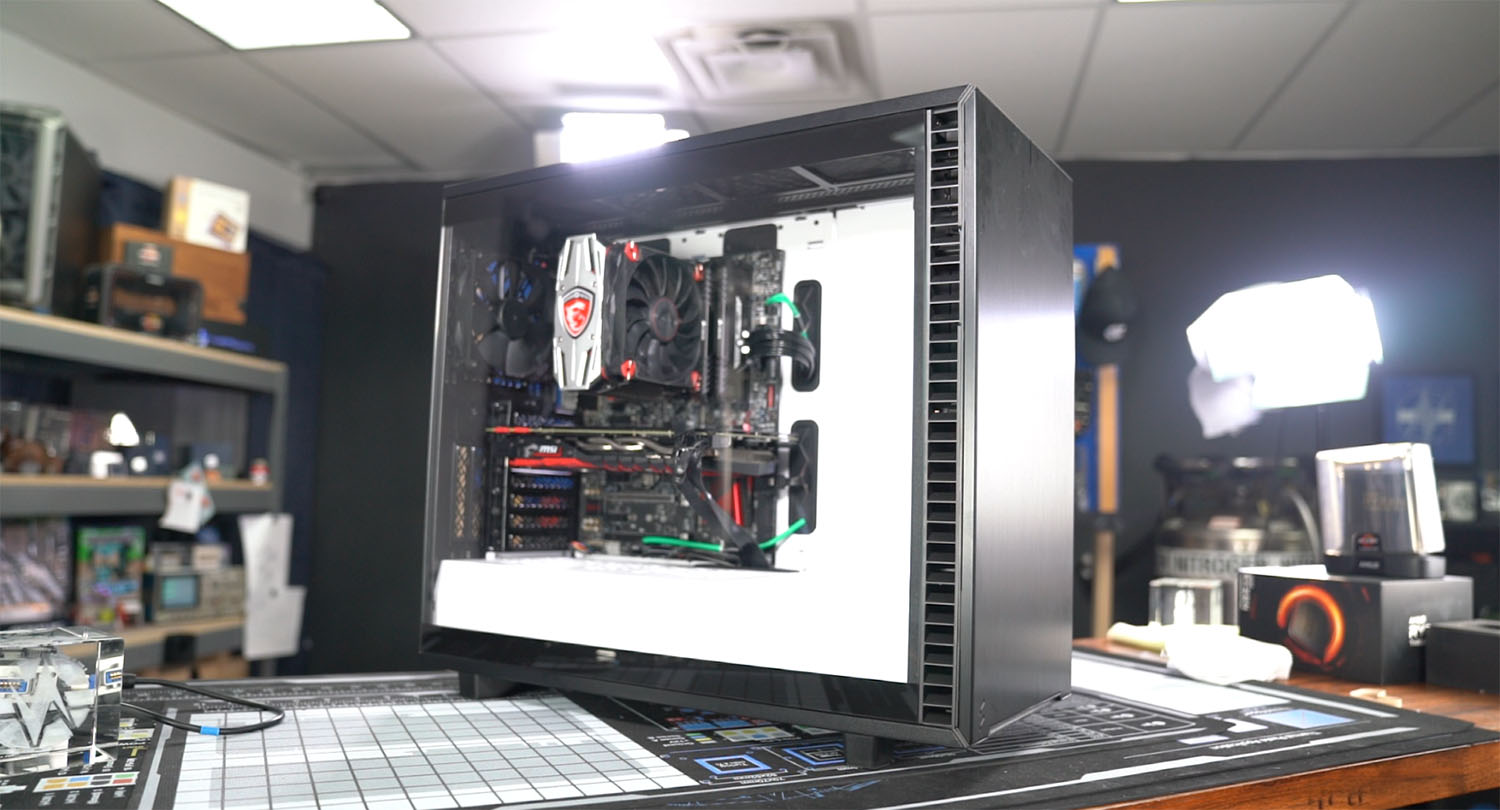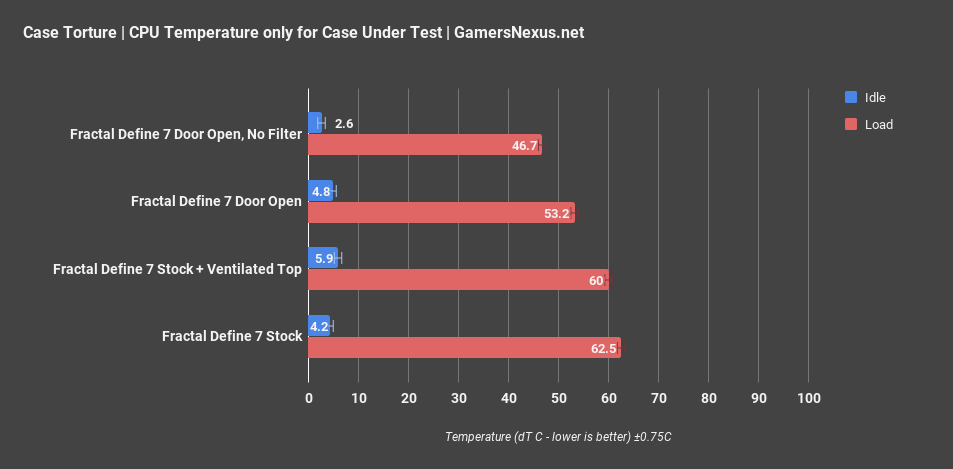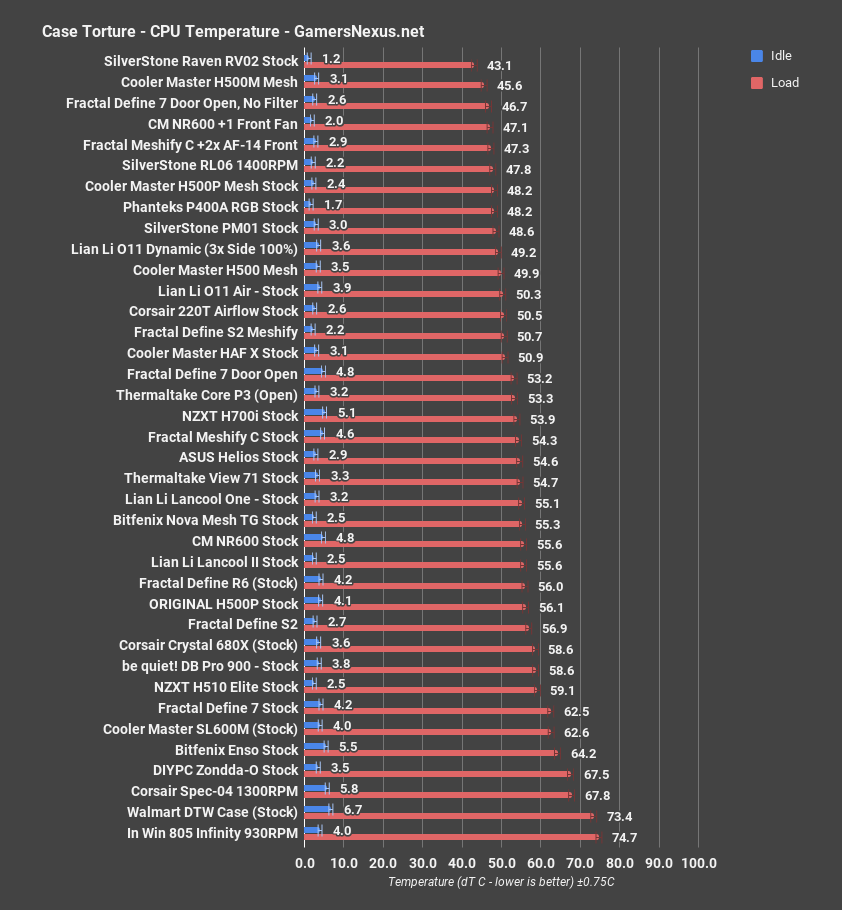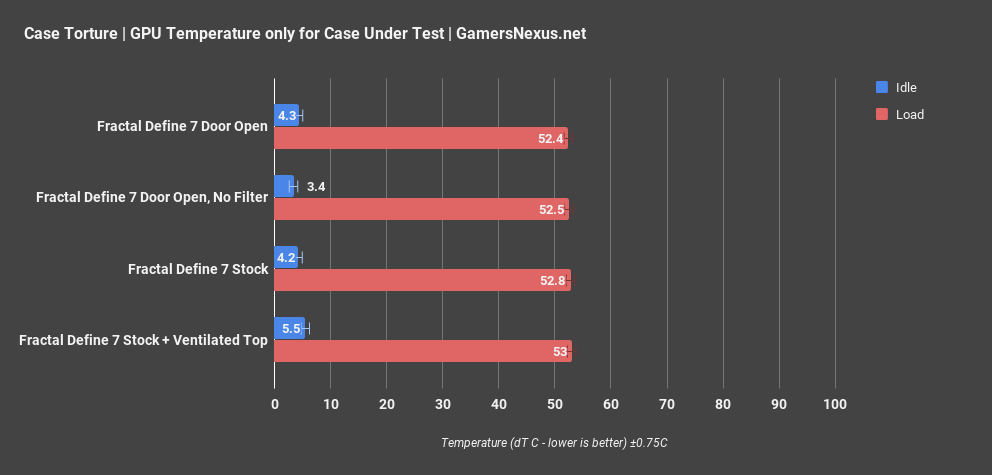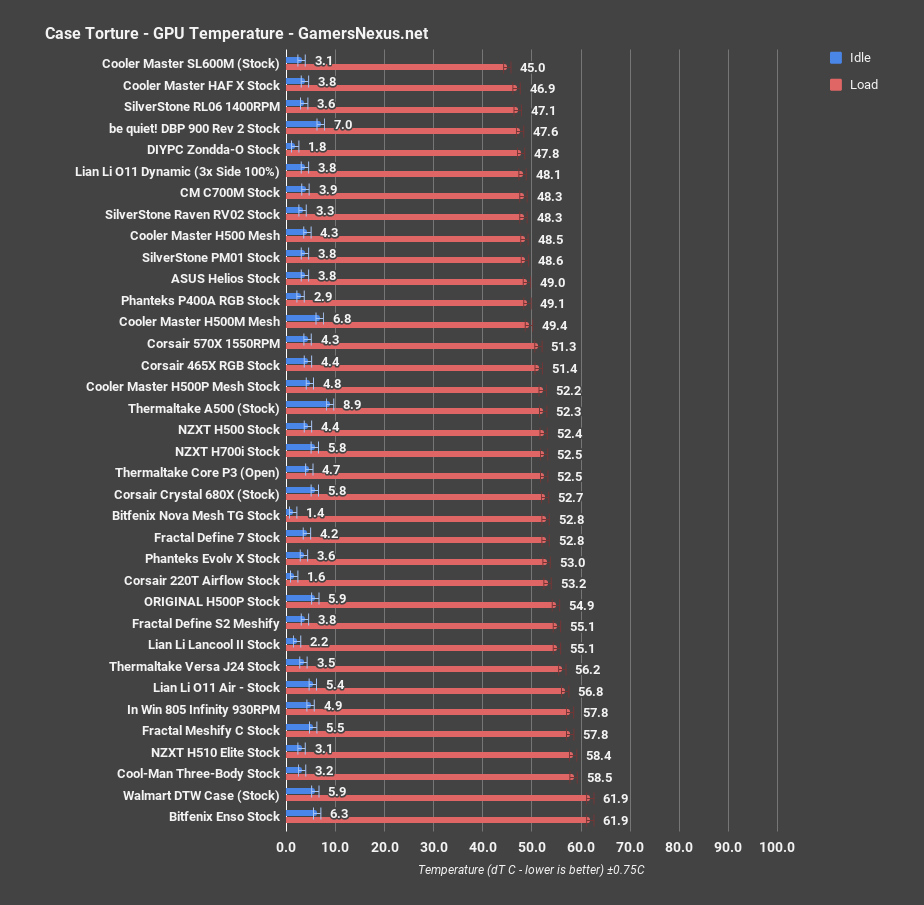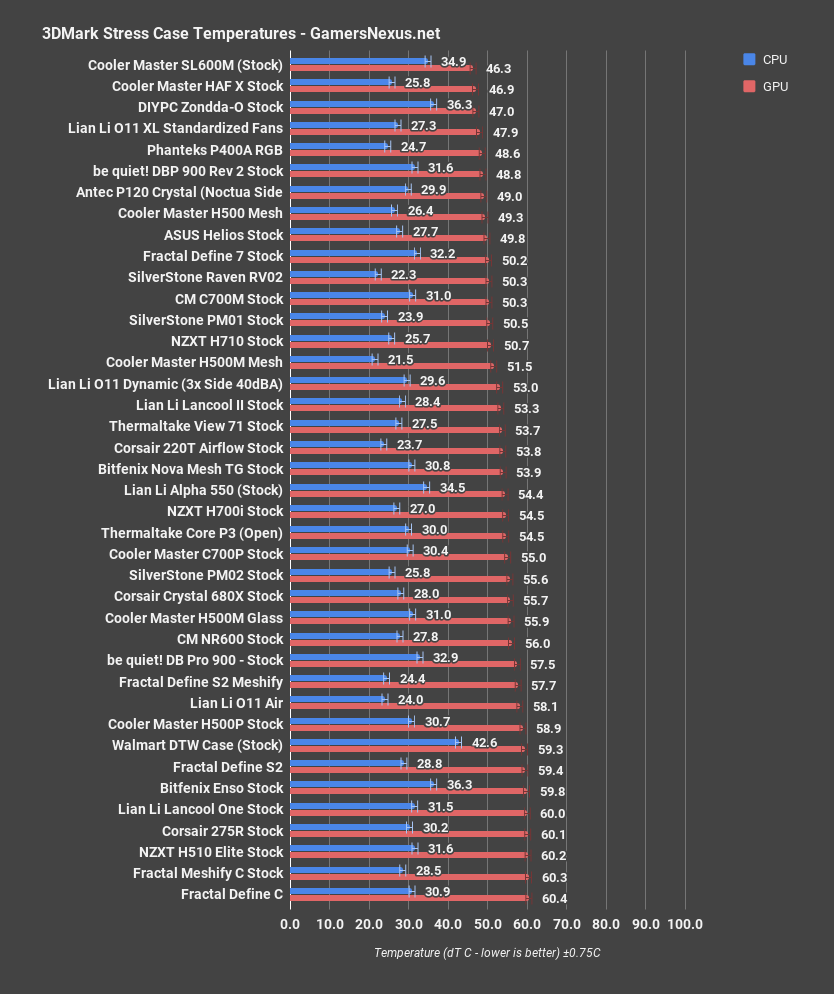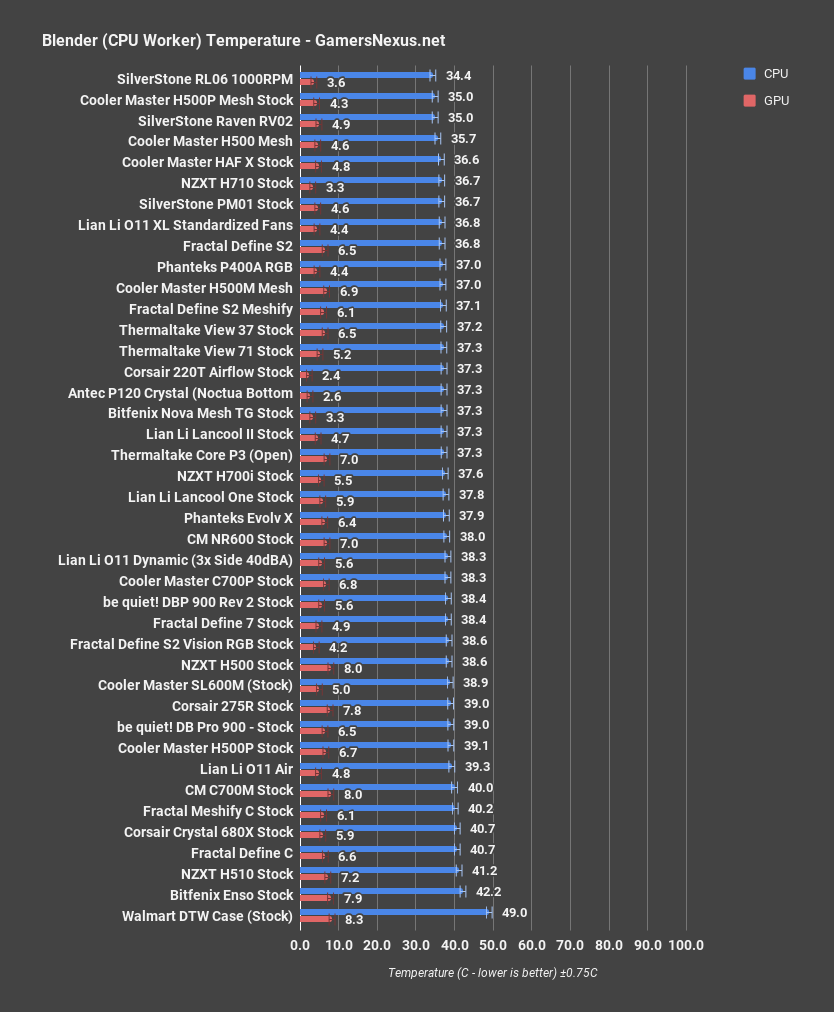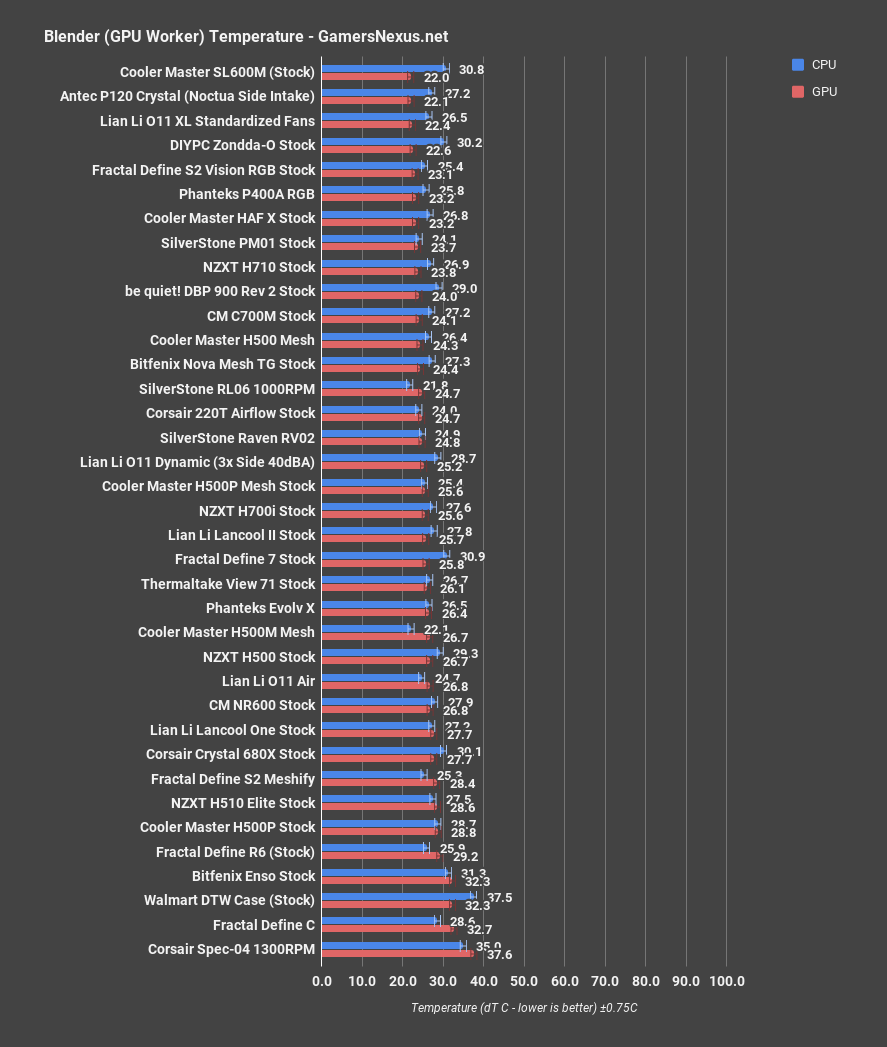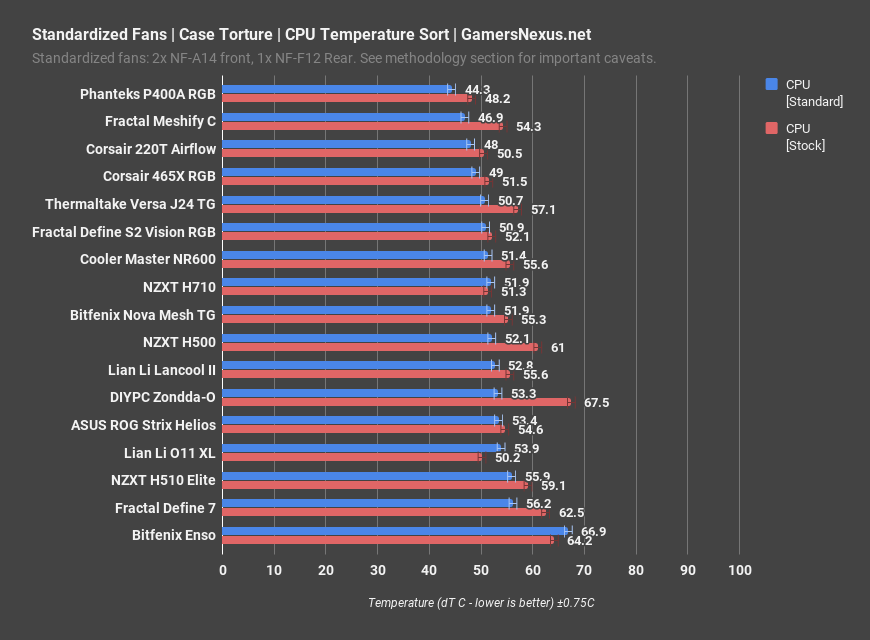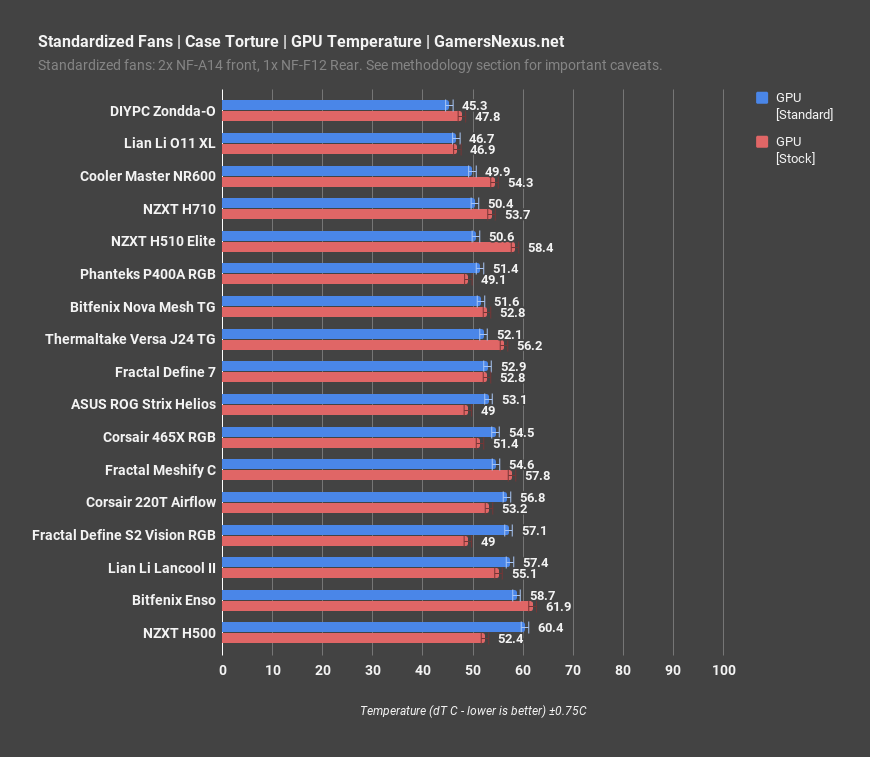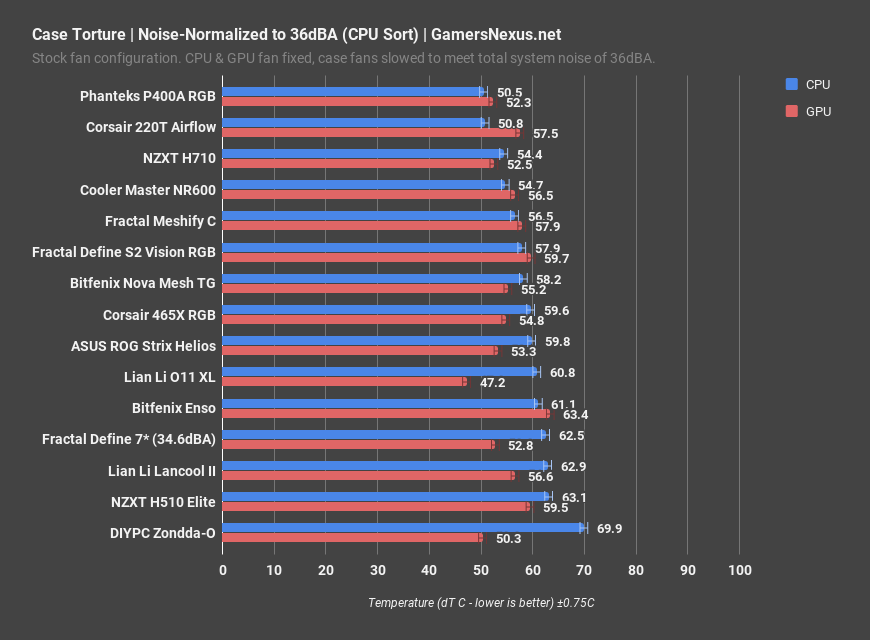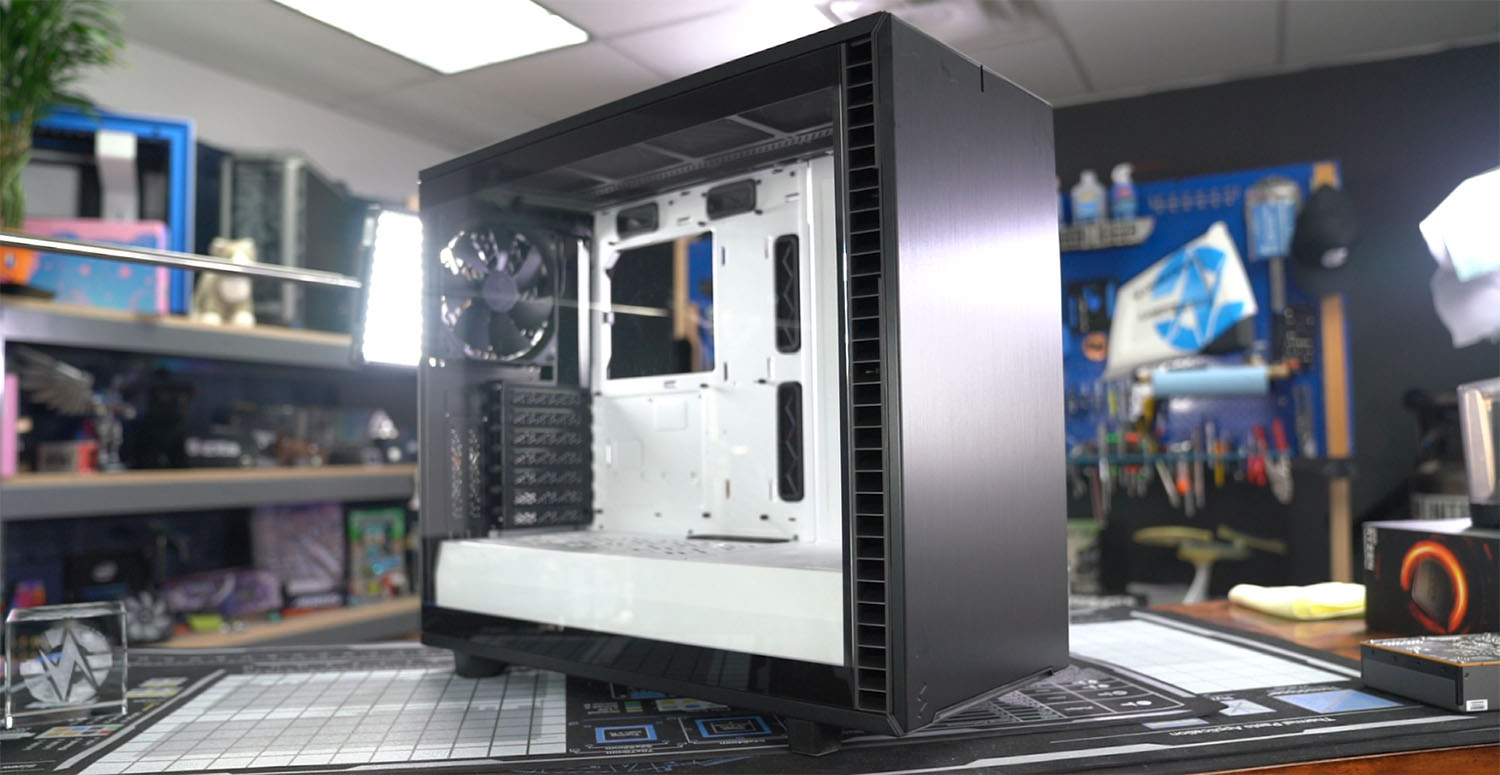We’ve been hot and cold on Fractal over the past couple years. Their whole lineup has had consistently high build quality, but our opinions have ranged from the highly-rated Meshify cases that have excellent cooling potential (with some aftermarket fans added in) down to the highly-priced and unexciting Define S2 Vision RGB. Today we’re reviewing the Define 7, successor to the Define R6, a case that fell on the positive end of that scale in our review. We’re sure there’s some reason for Fractal dropping the “R,” but we neglected to ask.
As soon as the Define 7 was out of the box, we noticed how lightly tinted the glass was. The Define 7 TG comes in both dark tint and light tint versions, and the light tinted version with a white interior is a stark contrast to almost every other tinted glass case we’ve reviewed. For whatever reason, case manufacturers have tended towards extremely dark glass tints for years, which is a step back from the transparent plastic windows that were more common in the olden days (a decade ago). The choice is there for customers who want the dark tint, but we much prefer clear glass that lets the white interior shine.
Fractal Define 7 Specs
3.5"/2.5" drive mounts | 6+1 included, 14 max |
Dedicated 2.5" mounts | 2 included, 4 max |
5.25" drive bays | 1 |
Expansion slots | 7+2 vertical |
Motherboard compatibility | E-ATX/ATX/mATX/ITX |
Power supply type | ATX |
Front interface | 1x USB 3.1 Gen 2 Type-C 2x USB 3.0 2x USB 2.0 Audio I/O Power/Reset buttons |
Total fan mounts | 9x 120/140mm |
Front fan | 3x 120/140mm (2x 140mm fans included) |
Top fan | 3x 120/140mm |
Rear fan | 1x 120/140mm (1x 140mm fan included) |
Bottom fan | 2x 120/140mm fan |
Dust filters | Bottom fan + PSU Front fans + ODD bay Top panel |
Front radiator | Up to 360/280mm |
Top radiator | Up to 360/420mm |
Rear radiator | 120mm |
Bottom radiator | Up to 240/280mm |
PSU max length | 353mm w/one HDD cage 227mm w/two HDD cages (cages in forward position; additional space required for front fans/radiators installed below the shroud) |
GPU max length | 491mm total 467mm with front fan 315mm in Storage Layout for cards over 150mm width (including power connectors) |
CPU cooler max height | 185mm |
Cable routing space | 30mm |
Extra features | Cable routing grommets Fixed velcro straps Tool-less push-to-lock on side & top panels Captive thumbscrews on HDD and SSD brackets |
Case Material | Steel, Tempered Glass |
Left side panel | Sound-damped steel or Tempered glass |
Right side panel | Sound-damped steel |
Case dimensions (LxWxH) | 547x240x475mm |
Case dimensions w/o feet/protrusions/screws | 533x240x451mm |
Net weight | Solid: 13.49kg/TG: 13.45kg |
MSRP | Solid: $160/TG: $170 |
Speaking of side panels, the Define 7’s are a combination of every feature we’ve asked for in case side panels so far. They hook into the case at the bottom edge so that they won’t fall when being removed, they attach/detach with sturdy snaps along the top edge aided by a small handle on the back, and the glass panel also has a tab that can be screwed down for extra security. The glass is full-coverage and has minimal black borders at the top and bottom for the largest possible viewing window. It’s easy to work with, it’s not unnecessarily complex, and it works well. The top panel shares the same snap mounting mechanism and can be removed by hooking a finger under the front corner and pulling it up.
The front panel of the case is a sticking point for us, as it always is with Fractal’s non-Meshify cases, but we’ll save most of that discussion for the thermal and noise testing sections. The panel isn’t nearly as ventilated as it could be, but Fractal has a focus on noise damping in their cases, and noise versus thermals is always a delicate balance to strike. As long as Fractal doesn’t advertise this as an “airflow” case and sticks to its noise-focused advertising, we don’t need to be as aggressive on the panel choices. It’s when companies mismarket their products that it’s a huge problem. The front is only held closed with a magnet and hinges open easily to reveal the front filter, so running the case with the door open during intense workloads isn’t out of the question. The hinges are constructed of metal and are therefore potentially sturdier than the ones found in the Dark Base Pro 900, but they’re still fairly delicate and mounted to a plastic frame, so we expect this to be a point of failure.
The filter at the bottom of the case extends the full length and width of the case, it’s accessed from the front of the case, and it can be removed easily without opening the front door of the case. That’s all we could ask for. The front filter isn’t quite as perfect: it snaps into place tightly enough to feel like something’s wrong, and the handle doesn’t provide great leverage for prying it off. The optical drive bay has a separate, smaller filter over it, which is a nice touch that allows fans or radiators to take the place of the optical drive if this space is left empty. The space between the two filters is still a significant obstruction, though, so we’ll be checking whether that matters in the thermal section later on. The top filter pops in and out more easily than the front one, and it’s generously large, covering almost the entire width and length of the case.
There’s an unusually long and skinny fan hub tucked into the cable channel along the top edge of the case. Fractal claims several positive features for this hub, but the one that actually matters is that it has six outlets for 3-pin fans and three outlets for PWM fans with a maximum combined output of 30W. The hub takes PWM input from the motherboard for speed control and draws power from a SATA connector. We didn’t use the fan hub for our tests because we need to monitor fan speeds individually, but Fractal gets points for hiding it away so effectively while providing nine fan connections. The positioning is the best use of the top part of the case we’ve seen in a long time.
Cable management is fine, and there are NZXT-style built in velcro straps and cable channels, but they’re somewhat superfluous given the cavernous interior of the PSU shroud. Even with the HDD cage installed, it’d be hard to create a scenario where the shroud wouldn’t fit every inch of slack cable. To help with this, Fractal has included a plastic shield that clips over the shroud opening to keep all the cables mashed in where they belong. At least, we assume that’s what it’s for. Since the steel side panel can’t be screwed into place, there needs to be an extra line of reinforcement to keep bulky cables from pushing the panel open. To that end, we’d like a couple screw holes on either the plastic cover or the steel side panel to allow us the option to screw them down tightly.
The HDD cage under the PSU shroud fits two drive sleds, but with so many mounting options inside the case, that’s barely worth mentioning. What is worth mentioning is that Fractal has fully taken advantage of the extremely long case form factor by mounting the cage on rails that allow it to be placed anywhere from right against the PSU to flush with the front panel. Even better, the rails can be used to mount HDDs or fans directly to the bottom of the chassis as well. Putting fans under the PSU shroud like this has limited usefulness (although the top of the shroud is ventilated), but Fractal was able to provide that option and so they did, which is a mentality we appreciate. More options is better than fewer.
In that same vein, we also received an accessory kit with the Define 7 containing an entire replacement top panel. Using this panel defeats some of the noise damping features of the case, but it does allow mounting fans and radiators, vastly expanding the cooling options. The downside of swappable panels like this is that customers are inevitably going to pay for a panel that they don’t use, but the ability of the Define 7 to switch from a silence-focused case with a ton of drive mounts to a liquid-cooled case with massive radiators and a reservoir at the front, or anything in between.
There is a maximum of 14 3.5” drives supported in the Define 7. The wide empty space at the front of the case can be filled with a rack of drive sleds, of which four are included, which added to the two sleds inside the HDD cage and the one drive that can fit next to the HDD cage makes for seven drives that can fit in the stock case. We sometimes have complaints about things like drive sleds being made available for purchase separately rather than all being included with the case, but seven is a lot of HDDs. Obviously using the space at the front of the case for anything else, like radiators or reservoirs or an optical drive, will reduce the number of drives supported.
The Define 7 lists support for E-ATX motherboards, and it does indeed have support for motherboards up to 11 inches in width by our measurement. We think Fractal has missed a trick here by not allowing even wider boards. The EVGA SR-3 that we’ll be using to build a production system in an upcoming stream is an E-ATX board 13 inches wide. Boards this size are uncommon, but there’s very little stopping the Define 7 from fitting it, or at least being easily moddable to fit it. As it is, the reinforcing lip at the edge of the motherboard tray and the lack of standoff holes would make it risky at best to install the SR-3 in this case. Fractal could sell a tray extension for the Define 7 as it is now, but the raised lip would still touch the back of the board. This is something very few cases get right, because “E-ATX” doesn’t really mean anything when it comes to a defined width; at least, not in the same way that ATX does.
There are a few final minor features we’d like to recognize. The front I/O still includes a full complement of four USB type A ports (two 3.0 and two 2.0) as well as a USB C port and separate mic and headphone jacks. The PSU attaches to a frame and is inserted into the rear of the case, which is fairly common but always an appreciated feature in cases with PSU shrouds. The top radiator mount is a removable tray, but even more so than usual, allowing most of the top of the case to be lifted off rather than just a discrete tray. We always appreciate removable radiator trays, but this one should make working with tubing especially easy.
GN Case Testing Bench
| Component | Courtesy Of | |
| Video Card | MSI GTX 1080 Gaming X (OC Mode) | MSI |
| CPU | Intel i7-6700K @ 4.4GHz | GamersNexus |
| CPU Cooler | MSI Core Frozr L | MSI |
| Motherboard | MSI Z170A Gaming M7 | MSI |
| Memory | Corsair Vengeance LED 32GB 3200MHz | Corsair |
| SSD | Samsung 850 EVO 120GB | Samsung |
| PSU | Corsair RM650x | Corsair |
| Cables | CableMod Pro Mesh Cables | CableMod |
| Case | This is what we're testing! | - |
The video card is configured to run at 55% fan speed at all times.
Prior to load testing, we collect idle temperature results for ten minutes to determine the unloaded cooling performance of a case's fans and air channels. Thermal benchmarking is conducted for 1400 seconds (23 minutes), a period we've determined sufficient for achieving equilibrium. The over-time data is aggregated and will occasionally be compiled into charts, if interesting or relevant. The equilibrium performance is averaged to create the below charts.
Load testing is conducted using Prime95 LFFTs and Kombustor “FurMark” stress testing simultaneously. Testing is completely automated using in-house scripting, and executes with perfect accuracy on every run.
Thermal Testing
For thermal testing in this review, we’re testing four total variations of the Fractal Define 7 alongside all the other cases. For the variations, we’ll be testing the full stock Define 7, the Define 7 with the door open, the door open and the filter removed, the full stock complement except with the top panel swapped for the ventilated top panel (door closed, filter attached), and then we’ll have separate charts with our standardized fans and noise-normalized thermal testing.
CPU Torture
As always, we’ll start with CPU torture thermals for only the Fractal Define 7, then we’ll get into the comparative numbers. The stock CPU thermal result had Fractal’s stock Define 7 running comparatively hot -- too hot, really, even without the airflow marketing -- at 62.5 degrees Celsius over ambient. As you’ll see in the later chart, this puts it toward the bottom of overall case performance. Fractal could improve here with better fans or with a less obstructive filter design, which would open-up some breathing room. Opening the door, we drop almost 10 degrees down to 53 degrees Celsius over ambient. That’s not surprising and it’s good that the door can be so easily opened, as you could always just open it for heavy loads. What’s more shocking is the extent to which removing the filter after opening the door still improves things, bringing it down to 46.7 degrees over ambient. Dropping an additional 6.5 degrees after shedding nearly 10 is insane. Fractal’s biggest weak point in thermal design is the filter; although the door does worse things, we understand that not every case can have a mesh front, but the filter could be improved without even showing anything. We’d still like to see the front improved elsewhere, like with additional ventilation or a wider spacing against the chassis. As for the ventilated top, that’s about 2.5 degrees cooler than the stock configuration. Note that this will change heavily based upon how you’re using it: With an air cooler, you’re going to get some additional draft through the top panel and into the tower cooler, assuming you maintain the stock configuration. Going too hard on positive pressure at the front may turn the top into a more likely exhaust.
CPU Torture - Comparative
Here’s the comparative chart. Fractal’s Define 7 stock performance runs toward the bottom of the cases, and is one of the worst we’ve tested recently. It’s unfortunate, but the positive side is that opening the door isn’t really a modification or a deviation from how the case is intended to be used. The takeaway is basically that, if you’re running a high power workload, you should open the door. Stock performance is nearing Bitfenix Enso levels of terrible, and that’s all because of the door. With the door open -- again, no removal of panels required -- it’s down to 53 degrees over ambient. That puts the case next to the Core P3 open air chassis, the Cooler Master HAF X, and not distant from the stock Meshify C. This transitions the Define 7 toward above average performance, so that’s a good spot to be. The craziest thing is that Fractal could throw a mesh panel on its Define 7 and create an “airflow case,” and it’d manage one of the best performers on the charts. We’d love to see Fractal offer an ultra-fine filter version of this case, since it’s stellar in build quality and design and could be a thermal chart-topper with only one panel changed. Without its restrictive filter or door, the case runs next to the H500M Mesh and NR600 with one extra fan, and the NR600 has an ultra-fine filter on the front. Fractal, if you’re listening, please make another variant. No RGB, though.
GPU Torture
GPU torture thermals for only the Define 7 are up now. The results are nearly identical across the board and are within test error. There is no meaningful difference between any of these results. We think there would be actual changes to performance if Fractal had a fan positioned lower on the front, but the lack of GPU-focused fans means that changes to the front panel have minimal impact. Most of the air that the GPU pulls is coming through the rear PCIe slot covers and vertical PCIe slot covers, which is unaffected from front panel changes. All of that extra air intake from the front goes straight to the CPU. There are some small frequency steps in some of these, but nothing significant.
GPU Torture - All
Comparatively, the Fractal Define 7 isn’t particularly impressive or unimpressive for GPU thermals. It’s not great, but it’s also not anywhere as close to the bottom as in the CPU testing. The Define 7 ends up about where the Corsair 680X is, and that’s a glass-fronted cuboid-like case, and isn’t far from the 220T Airflow or Core P3. If you were to fit another expansion card in here, it’d potentially have drastic impact on GPU thermals since most of the air comes through the rear of the case.
3DMark
3DMark thermals are next. These numbers typically closely mirror the GPU torture numbers, as it’s a GPU-heavy load, but they can be impacted by the reduction on CPU focus versus our torture workloads. The 3DMark test loads the system similarly to how a game would, and so this is a stand-in benchmark for game thermals.
The Define 7 ends up overall above average to good in this test. It’s toward the top of our truncated chart, with the RV02, H500 blank Mesh, and H710 all nearby. For a gaming-style workload, the Define 7 does fine and doesn’t need the door to be opened on our bench. Now, of course, a higher power load configuration might be different, so keep in mind that big overclocks or poor GPU coolers would potentially change this statement.
Blender
Blender thermals are next, another real-world workload. This one is split between CPU and GPU renders to isolate the parts.
Fractal’s Define 7 shows itself again underwhelming for CPU performance, ranking toward the lower third of results. The Define 7 is near the S2 Vision, which is one of the worst cases we’ve tested recently, and the C700P. That said, none of these are particularly bad in CPU thermals, and Blender doesn’t establish much of a top-to-bottom difference to begin with. It’s a lightweight load, and goes to show that only the truly terrible designs -- like the DTW case -- are able to deviate in big ways from the mean.
For GPU thermals with Blender, the Define 7 does OK and is in the middle of the results. At 25.8 delta T over ambient, we don’t really have anything to complain about or to praise. The CPU thermals ar ehigh, though, at 31 degrees versus neighboring results of 27, 22, and 28 degrees over ambient.
Standardized Fans
Our standardized fan testing is next, where we replace the fans with a defined set of Noctua fans, including two 140mm front fans and one 120mm rear fan. We keep the fans in the same positioning as stock when possible, as it is here, and we also mark each fan so we know which of the two front fans goes in the top versus the bottom, as their natural RPM manufacturing variance will matter for this.
For the CPU-sorted results, the Define 7 improves from 62.5 degrees stock to 56.2 degrees just by replacing the fans with significantly better ones. Of course, the downside to noise-focused cases is that you can often outperform them both acoustically and thermally with an open panel, since you don’t have to run RPM as high to counter the front panel. The 56.2-degree standardized fan result has it toward the bottom of the chart, second-worst only to the Bitfenix Enso. That’s not a good result, and reinforces the Define 7’s particularly weak CPU cooling. Remember, modern Ryzen CPUs will lose clocks every 5 degrees or so, so these numbers matter a lot these days.
For the GPU results, the Define 7 ends up dead-center. Results don’t meaningfully change from stock since there’s still no fan pointed at the GPU directly, so we’ll move on.
Noise & Noise-Normalized Results
Noise levels for the Fractal Define 7 at a standardized measuring distance of 20” plotted 34.6 dBA with the door closed. To its credit, the door is actually doing something other than suffocating the CPU, because opening the door brings noise levels to 38.9 dBA. That said, that’s not really fair to say, because you could also run the fans significantly slower and achieve better-than-stock performance, which would be a net positive. We had a whole video on this previously.
Standardized thermal testing puts the Define 7 at a natural disadvantage, because it’s one of the only cases we’ve worked with that runs as quietly as it does; in fact, the Define 7 is below our 36dBA normalized threshold for noise testing, plotting instead at 34.6dBA, and that’s with its included fans at maximum speed. Even still, with this noted, the case is doing better in CPU thermals than a few others on the chart. An extra 1dBA worth of fan RPMs honestly wouldn’t change much in this setup, anyway, but might propel it more toward the O11 XL or Helios. The GPU thermals put the Define 7 actually very near the top of the chart. This, we think, is again because of the GPU intake through the rear of the case as a result of the pressure system being created.
Conclusion: Fractal Define 7 Review
We criticized the Fractal Define S2 in the past for being basically the same case as the Define R6. The Define 7 is also very similar to the R6, but that makes much more sense for a successor, and the 7 also has some meaningful quality-of-life improvements over the R6 that are worthy of a new case. The Define 7 is up to Fractal’s usual standards of build quality, it’s quiet, it’s flexible by nature, and it doesn’t have the worst possible cooling performance, although we’d definitely recommend some aftermarket fans. $170 is a higher-than-average price for a nice PC case--we’d be more comfortable recommending it to a general audience at $150, especially given the stock cooling performance. That said, the Define 7 is a well-constructed case that’s a great platform for liquid cooled systems, and enthusiasts buying it for that purpose won’t be disappointed.
Editorial, Test Lead: Steve Burke
Editorial, Testing: Patrick Lathan
Video: Keegan Gallick, Andrew Coleman
